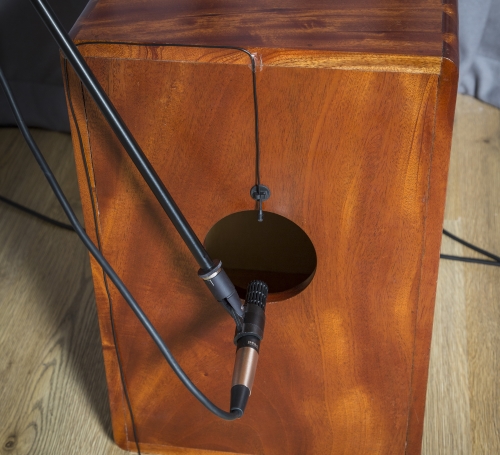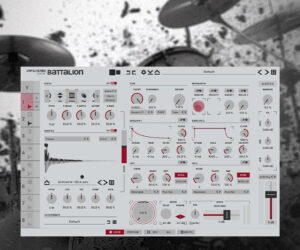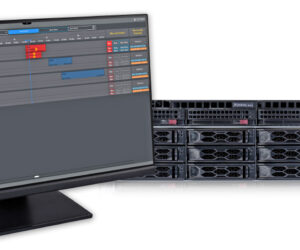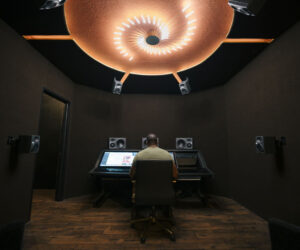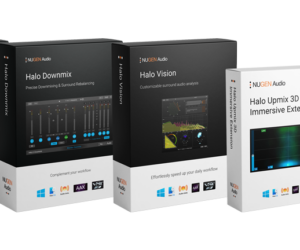The all-wooden box drum or cajón may be one of the hardest instruments to amplify, because it produces sharp bursts of sound energy (transients) when played.
Finding the right microphones to capture the subtle “woodsy” tone and transient-rich sound of his cajón was proving to be a challenge for percussionist David Mortara – until he discovered the DPA Microphones‘ d:dicate range.
Mortara is the band leader of Malambo, a London-based group performing Canción Criolla (Creole Song) and Afro-Peruvian music. Malambo has performed in many of London’s top music venues and festivals, including the Southbank Centre (Royal Festival Hall and Queen Elizabeth Hall), the Bloomsbury and Ealing Festivals,and on the club and corporate entertainment circuit. Corporate gigs can take place in some very unusual and acoustically problematic spaces not designed for critical listening – such as the Victoria & Albert Museum Refreshment Rooms and Cannon Bridge Roof Gardens in London.
Mortara plays a variety of ethnic percussion and his principle instrument is the cajón. Originally from Peru, this all-wooden box drum is played by slapping the front face with the hands, fingers, or sometimes various implements such as brushes, mallets, or sticks.
“For years, I struggled to achieve a decent, faithful live sound on cajón with those popular models of directional dynamic microphones one encounters on-stage,” explains Mortara. “Although directional dynamic microphones can be great, my sound always lacked articulation and ‘sparkle’; as greater mass and inertia of the moving parts in dynamic microphones (compared to condenser microphones) ‘smear’ transient details.
“Also, the sound character of my instruments would change when placing directional dynamic microphones up very close, to minimize reverberant spill and feedback, because these microphones exhibit bass ‘tip-up’ (known as proximity effect). I’d spend ages during sound checks getting the engineer to adjust EQ settings for something sounding natural. On occasions, my cajón would end up sounding like I was playing a biscuit tin.”
After hearing good reports about DPA microphones, Mortara contacted UK distributor Sound Network and was put in touch with Les Mommsen, chief technician at London’s Union Chapel, who suggested a close mic solution that involved the use of two d:dicate 2011C cardioid condenser microphones – one front and one rear – plus a d:screet 4061 miniature omnidirectional condenser capsule, which was used as a low level mixing option and positioned on the ‘sweet spot’ of the cajón’s rear sound porthole.
In his capacity as a freelance sound engineer, Mommsen provided sound tech services at two recent Malambo gigs – one at Ceviche Old Street, a large and busy restaurant in London’s financial quarter and another at a private venue in Kent.
“The DPA solution was ideal because it delivered a very natural low end response and allowed us to capture a really big sound from the cajón,” Mommsen says. “The restaurant venue, in particular, was a challenging acoustic environment because it had a lot of tiled surfaces and was also pretty noisy. By close miking the drum, we were able to reduce off-axis spill and really capture the nuances and subtlety of the instrument.”
For both gigs, Mommsen also provided a d:facto vocal microphone for Malambo’s d:dicate 2011C cardioid condenser microphones – one front and one rear – plus a d:screet 4061 miniature omnidirectional condenser capsulelead singer Juanita Euka, who recently won Vocalist Of The Year 2016/17 at the annual LUKAS Awards that celebrate Latin American arts and culture in the UK.
“The d:facto is a real hit with Juanita because it doesn’t color or distort her voice in the way some other popular microphone brands do,” Mortara says. “Recent performances have sounded fantastic and I’m personally very happy with the mic set-up Les has put in place on my cajón. I receive regular compliments and questions from other percussionists regarding my sound reinforcement, because the cajón is such a popular instrument, and yet it can be problematic to amplify, live. Now, I happily recommend DPA microphones as the solution to delivering superb on-stage cajón sound.”


